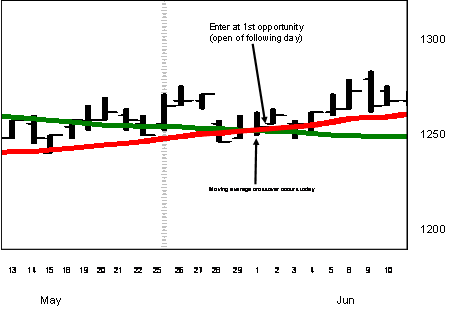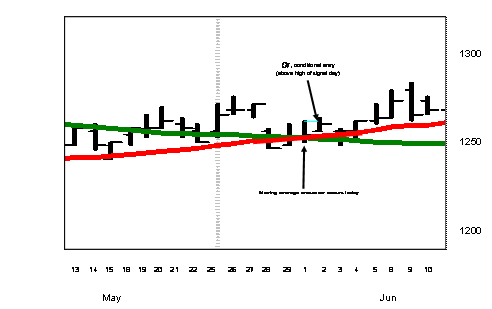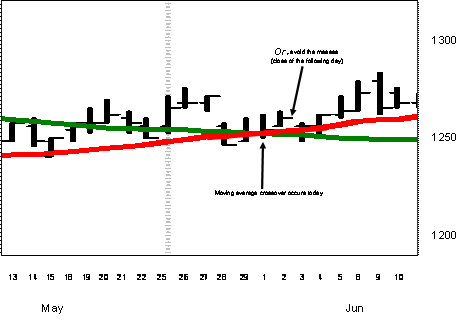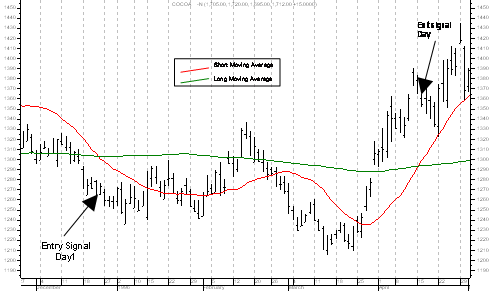![]()
The Seven Elements
of a Complete System
In a nutshell, a system specifies the rules that will be installed in your trading software, giving rise to ‘buy’ and ‘sell’ orders. In using the word ‘system’ we mean a complete system as described below.
The seven elements which make up a complete trading system are:
1. What to Trade?
In STEP 2 you chose your trading universe and obtained a list of commodities you would be trading. So the ‘What to Trade?’ question has been answered – it is all the commodities on that list.
Every day, your system will look for any signals arising for commodities on the list.
2. When to Trade?
The answer to this question is always ‘when the signal is given’. But the signal can be either a ‘buy’ or ‘sell’ signal. Whether or not there is a signal at all and whether it is ‘buy’ or ‘sell’ depends on the Entry Rules.
Entry Rules
A simple way of generating entry signals is to employ a moving average crossover system.
The dual moving average crossover (DMAC) is a simple entry rule. A ‘buy’ (long) entry signal is generated when the shorter term moving average line (red) crosses above the longer term line (green).
The following chart shows a ‘buy’ signal being generated by DMAC.
The chart shows (arrowed) the day when the crossover occurred, generating a ‘buy’ signal. So, we have been told WHEN to trade - it is determined by the day of the signal.
Many traders seem to despise such simple procedures, preferring to use more ‘sophisticated’ rules - these traders tend to be found among the majority group -of losing traders!
This element of the system is commonly and mistakenly referred to as the system itself but as will be shown, the trade entry is only a small, albeit important part of the whole process.
When you start testing systems in STEP 4, you will see how a potentially profitable trade entry plan can be badly managed at later stages in the trading process resulting in poor results or conversely, how a moderately promising entry idea can deliver great returns by wise trade management. This illustrates how the complete trading system is far more than just a good trade entry rule.
3. How to Trade?
In the example above, when the dual moving average crossover took place, a buy signal arose. The price at which this happened is ‘fixed’ at the price value of the green line on that day. Let’s say the day was Monday 1 st June and the green line average was $12.50 on that day and that the commodity is ‘Soybeans’.
When we send an order to our broker, it isn’t enough just to tell him when to trade, we have to tell him how we want him to get us into the market. In other words ‘How to Trade?’ In this matter, there are many choices and we will look at three of them as examples:
a) On the opening of the day following the signal.
b) One tick above the high price of the signal day.
c) On the close of the day following the signal.
The instructions a), b) and c) tell the broker “How To Trade”.
Note that we do not send the broker any of these orders until the market has closed on Monday 1 st June, by which time we know that the crossover has occurred. The orders are timed to reach the broker before the market opens on Tuesday 2 nd June.
Example a) Order is ‘Buy Soybeans on the opening of the day following the signal’.

The broker will fill our order by buying at whatever price he can get (a market order) when the market opens on 2 nd June.
Example b) Buy Soybeans at ‘1 tick’ above the high price of 1 st June.

Let’s say Soybeans reached a high of $12.60 on the 1 st June (the signal day) and we give an order to buy Soybeans any time the price exceeds $12.60.
The broker will follow our instructions but of course there is no guarantee he will fill our order because the price might not go above $12.60.
Example c) Buy Soybeans at the closing price on 2 nd June.

The broker will fill our order by buying Soybeans at whatever price the market closes at on 2 nd June (a market on close or stop close only order).
4. How Much to Trade?
Now it stands out like a sore thumb that we haven’t yet told the broker how many Soybean contracts to buy. Your risk depends on the buying quantity and it is important to deal with the question scientifically.
The common sense idea is to stake a percentage of your capital on the trade, the more you’re worth, the more contracts you will buy. Therefore you would take the same risk, whatever the size of your capital as the extent of the risk is determined by the percentage staked.
Broadly speaking, this is what the MODUS Method does, because the commonsense view is held to be the best method.
What if you decided to stake a fixed $5000 on each trade? If you had a very large amount of capital, it seems obvious you would be under-investing and not making the most of opportunities. On the other hand if you had a small amount of capital, you would surely be over-stretching and taking bigger risks than you should. So it appears logical that a percentage of capital is the right approach.
OK, but the question has not yet been answered – what percentage?
Professional traders always seem less rash than beginners, who are keen to make lots of money and put their capital to the fullest use. Professional traders appear over-cautious to the person new to trading- they generally stake a maximum of between 1% and 3% on a trade.
The position sizing process calculates the number of contracts to be traded, so that the broker can be told ‘How Much To Trade.’ The MODUS Method of position sizing is described in more detail in STEP 4.
5. How to Exit a Winning Position?
In the same way that the “When to Trade” rule generates a signal to enter the market, there is always a rule which generates a signal to exit the market.
Between them, of course these rules are intended to leave you with a profitable trade but there is no guarantee that this will be the case. Nevertheless, the exit rule is referred to here as “How to Exit a Winning Position?”
It is not possible to say exactly what your exit rule will be, that depends on the system chosen. It is only necessary for you to appreciate that there will always be an exit rule and this will be the one your system will use unless the trade goes contrary to the way intended, in which case the “How to Exit a Losing Position?” will apply.
A Long Trade Example.
The dual moving average crossover system (DMAC) produces a ‘buy’ entry signal when the short term moving average line crosses above the long term moving average line. This is the signal which ‘gets you into the market’ when it is hit.
Conversely, when the short term line crosses below the long term line it produces a ‘sell’ signal. This is also the signal to exit any long trade in progress , by selling to close the position. Whether this is a winning trade or not is not important, what matters is that you are following the system you tested and accepted as satisfactory.
A Short Trade Example.
Short trades are mirror images of long trades and follow opposite rules. The only difference from a long trade is that a short trade is opened with a ‘sell’ and closed with a ‘buy’.

When the exit signal is generated by your system, instructions on when and how to close the trade must be sent to your broker, who will follow them in similar fashion to the instructions you gave him to open it.
About Open Positions
After a trade has been commenced, or opened, it will continue until a closing order is executed. While it is open, the price will be moving around all the time and at any given moment, there will be a profit or loss showing on it. This current profit or loss is called the ‘open status’ of the trade, or the ‘open equity’. You could cash in this open equity at any time, without waiting for a signal to do so, but this would violate the rules of your system.
Note that for all trades in progress on any particular day there would be a price at which your system would exit if that price was reached. Therefore an exit instruction for every open position is sent to your broker every day. Some day, every open position will reach an exit point and be closed.
So What If I Take a Profit – How Can That Be Bad?
Breaking your system rules by closing a trade on impulse puts you in uncharted territory. You tested your system thoroughly, to see how it would be likely to perform in the real market under specific rules.
Probably, there were some highly profitable trades during the system tests, which combined with all the other trades to produce the performance and return that you accepted.
Perhaps the trade you closed on impulse would have been one of these highly profitable trades. What has the fact that this trade was curtailed done to the results? It is likely that your interference will have produced a lower profit, in which case you will have also reduced the capital available to finance subsequent positions. There are many other possible ramifications too that all add up to the fact that this is no longer the system you ‘knew’.
Tell yourself that the open equity in a trade is there to lubricate the system and to make it work the way you created it. Tell yourself that open equity is not profit and it is not your money! By this means, hopefully, you will resist the fatal temptation to “take profits early” or “stop trades now.”
6. How to Exit a Losing Position?
Of course, not all trades are going to be winners. The fact is, in most hugely profitable trading systems only 25% to 35% of trades are winning trades. The systems still make money because the size of the average winning trade is greater than the average losing trade and many of the winners are much larger. This is because these traders practise the strategy of “run your winners and cut your losses”.
The dual moving average crossover system we have been looking at so far is perfectly tradable as it stands but most successful traders would criticize it in a few respects.
One serious weakness is that the system in its simplest form has no way of exiting a losing trade other than waiting for the moving average cross in the opposite direction. In other words, it has no way of cutting its losers, it has no protective stop.
A protective stop is an order to the broker to close the position if the market moves against it by a specified amount.
When a trade is opened, even the most experienced trader will tell you that he has no idea whether it will be a winner or a loser. If that shocks you just remember that the trader has developed and thoroughly tested his system and he is satisfied that his system ‘knows how to trade the way the trader wishes’ and that it is likely to perform in a certain manner as regards ‘risk and return’. He will know the sort of win/loss ratios over the time the system will run. Perhaps he is looking at a 5 year term. But he will not know what any particular trade might do and frankly, he will not be concerned either. His concern will most likely be that he follows his system well.
Therefore, he knows that sometimes his system will embark on losing trades – these are all counted in the overall expectation of the system. He will have considered to what extent his system should attempt to ‘ cut trades that appear to be wrong’. That means that he may, for example, have views about how a trade ‘should’ behave after it is opened. He may propose a limit beyond which the trade should be closed, then he will build this ‘protective stop’ into his system rules and test it!
Satisfied that his protective stop is worthwhile, the trader will use this as his answer to “How to Exit a Losing Position?”
Cutting losses will cut some winners too and so it is essential to make thorough evaluations of protective stops to ensure that they are set where they do much more good than harm.
7. What to do if Full?
System testing is often carried out assuming that all signals would be taken, irrespective of capital already committed on trades. In practise, this could not be done because at the very least your broker will require sufficient margin in the account to cover open trades.
Therefore, any test that does not recognize reality is worthless.
The MODUS Method sizes positions according to uncommitted capital and if there is no free capital it refuses the trade.
This is perhaps the least understood and the most insidious of all the checks the trader carries out to determine whether he has a complete trading system.
The question being asked is “how does the system behave if the trader has insufficient funds in his account to implement an entry signal?” When trading live, all traders are subject to restrictions due to the amount of capital they have. As a last resort, the broker will refuse to fill an order which cannot be funded owing to insufficient margin in the trader’s account. In other cases, open positions may be closed or unwound by the broker to satisfy margin requirements.
So, if the trader’s system does not control what happens when capital is insufficient to take trades, this represents a deviation just as serious as any other instance where a trader breaks away from his system and enters uncharted territory.
Modus Commodity Trading Course
![]()
Modus Trading
Contact David
Copyright David Bromley 2005
All Rights Reserved.

David Bromley
click for information